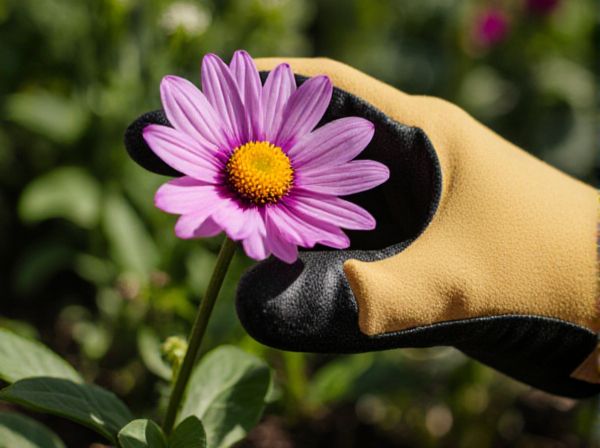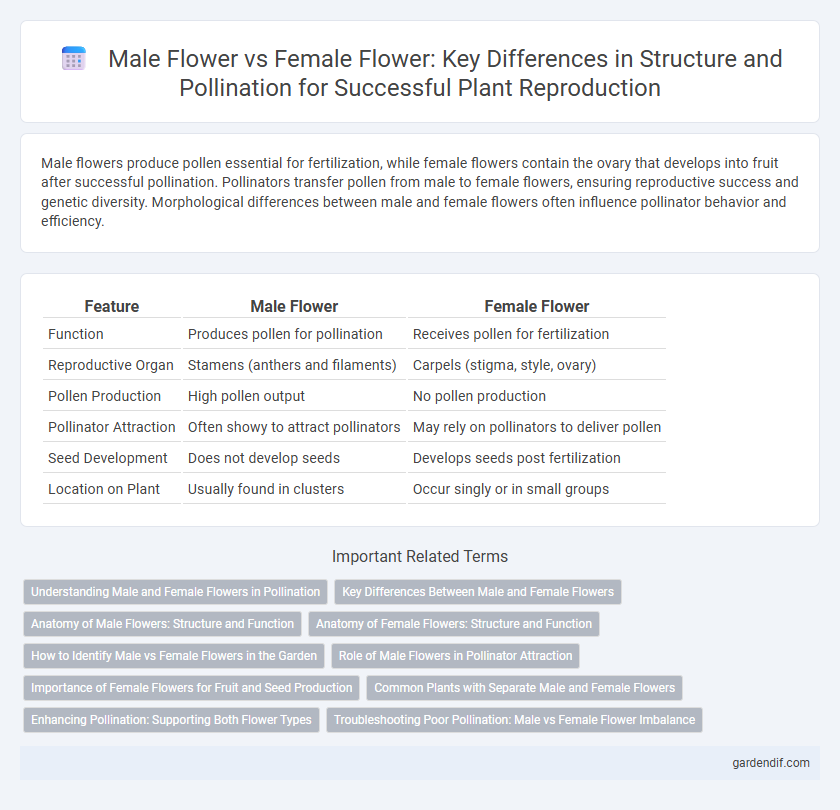
Male Flower vs Female Flower Illustration
Male flowers produce pollen essential for fertilization, while female flowers contain the ovary that develops into fruit after successful pollination. Pollinators transfer pollen from male to female flowers, ensuring reproductive success and genetic diversity. Morphological differences between male and female flowers often influence pollinator behavior and efficiency.
Table of Comparison
| Feature | Male Flower | Female Flower |
|---|---|---|
| Function | Produces pollen for pollination | Receives pollen for fertilization |
| Reproductive Organ | Stamens (anthers and filaments) | Carpels (stigma, style, ovary) |
| Pollen Production | High pollen output | No pollen production |
| Pollinator Attraction | Often showy to attract pollinators | May rely on pollinators to deliver pollen |
| Seed Development | Does not develop seeds | Develops seeds post fertilization |
| Location on Plant | Usually found in clusters | Occur singly or in small groups |
Understanding Male and Female Flowers in Pollination
Male flowers produce pollen grains essential for fertilizing female flowers, which contain ovules that develop into seeds after successful pollination. The structural differences between male and female flowers facilitate cross-pollination, promoting genetic diversity in plants. Pollinators like bees transfer pollen from male flowers' anthers to the stigma of female flowers, enabling reproduction and fruit formation.
Key Differences Between Male and Female Flowers
Male flowers produce pollen and are primarily responsible for fertilizing female flowers, while female flowers develop ovules that mature into fruit after fertilization. Male flowers typically have stamens composed of anthers and filaments, whereas female flowers contain pistils with stigmas, styles, and ovaries. The visual distinction often shows male flowers as smaller and less complex, while female flowers tend to be larger due to the presence of ovules and potential fruit development.
Anatomy of Male Flowers: Structure and Function
Male flowers contain stamens composed of anthers and filaments, with anthers producing pollen grains essential for fertilization. The structure of male flowers is specialized to maximize pollen dispersal through features like elongated filaments and dehiscent anthers. Functionally, these flowers play a critical role in pollination by releasing viable pollen that pollinators transfer to female flowers for successful reproduction.
Anatomy of Female Flowers: Structure and Function
The anatomy of female flowers is characterized by the presence of the pistil, which includes the stigma, style, and ovary, essential for pollination and seed development. The stigma serves as the pollen receptor, while the style provides a conduit for pollen tubes to reach the ovary, where fertilization occurs. The ovary contains ovules that, once fertilized, develop into seeds, making the female flower crucial in the reproductive cycle of flowering plants and a key focus in pollinator interactions.
How to Identify Male vs Female Flowers in the Garden
Male flowers typically have stamens that produce pollen, appearing in clusters, while female flowers contain pistils and develop into fruit, often featuring a swollen ovary at the base. In cucumber and squash plants, male flowers are usually on longer, thinner stems, whereas female flowers grow closer to the vine with a small, immature fruit behind the petals. Identifying these characteristics helps gardeners optimize pollination by ensuring both flower types are present and accessible to pollinators like bees.
Role of Male Flowers in Pollinator Attraction
Male flowers play a critical role in pollinator attraction by producing abundant pollen, which serves as a primary food source for many pollinators such as bees, butterflies, and beetles. Their vibrant colors and distinct scents are specifically evolved to lure pollinators, facilitating effective pollen transfer to female flowers for fertilization. This dynamic interaction enhances plant reproductive success and maintains ecosystem biodiversity.
Importance of Female Flowers for Fruit and Seed Production
Female flowers play a crucial role in fruit and seed production as they contain ovules that develop into seeds after pollination. Unlike male flowers, which produce pollen, female flowers are essential for the fertilization process that leads to fruit formation. Their successful pollination directly impacts crop yield and agricultural productivity.
Common Plants with Separate Male and Female Flowers
Common plants with separate male and female flowers, such as zucchini, cucumbers, and corn, rely heavily on pollinators to transfer pollen from male to female flowers for fruit development. Male flowers typically produce abundant pollen, while female flowers contain the ovary necessary for seed formation. Effective pollination by bees, butterflies, or wind ensures successful fertilization and maximizes crop yields in these monoecious species.
Enhancing Pollination: Supporting Both Flower Types
Male flowers produce abundant pollen crucial for fertilization, while female flowers contain ovules that develop into fruits upon successful pollination. Supporting habitats for both flower types ensures diverse pollinator visits, enhancing cross-pollination efficiency. Cultivating a balanced presence of male and female flowers boosts genetic diversity and crop yield through optimized pollinator activity.
Troubleshooting Poor Pollination: Male vs Female Flower Imbalance
Poor pollination often results from an imbalance between male and female flowers, disrupting effective pollen transfer. Male flowers produce pollen crucial for fertilizing female flowers, which develop into fruit; a deficit in male flowers reduces fertilization rates and crop yield. Enhancing pollinator activity and ensuring a balanced ratio of male to female flowers can mitigate poor pollination and improve fruit set.
Male Flower vs Female Flower Infographic

 gardendif.com
gardendif.com